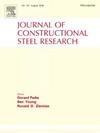使用 SVM 和 NSGA-II 对复杂钢接头进行基于 BIM 的智能优化
IF 4
2区 工程技术
Q1 CONSTRUCTION & BUILDING TECHNOLOGY
引用次数: 0
摘要
钢接头是结构中的重要承重部件。在一些结构(如大型桥梁)中,这些接头变得越来越复杂。然而,目前对复杂钢接头的优化主要依赖于经验知识和人工试错。本文提出了一种在 BIM 环境下使用 SVM(支持向量机)和 NSGA-II(非支配排序遗传算法 II)优化复杂钢接头的方法。最初,这项研究利用 Rhino、Grasshopper 和 Abaqus 创建了一个 BIM 框架,用于复杂钢接头的智能优化。首先对接头的部分组件进行参数化,然后实施有限元(FE)参数化建模。随后,利用参数化模型的 FE 分析结果,使用 SVM 训练复杂钢接头的替代 FE 模型。最后,在代用模型的基础上,利用 NSGA-II 实现优化设计。通过实际工程案例的对比实验,证明所提出的方法可以有效地帮助设计人员进行复杂钢接头设计。本文章由计算机程序翻译,如有差异,请以英文原文为准。
BIM-based intelligent optimization of complex steel joints using SVM and NSGA-II
Steel joints are vital load-bearing components in structures. In some structures like large-scale bridges, these joints become increasingly complex. However, the current optimization of complex steel joints primarily relies on empirical knowledge and manual trial-and-error. This paper proposes an approach for the optimization of complex steel joints using SVM (support vector machines) and NSGA-II (non-dominated sorting genetic algorithms II) in BIM environment. Initially, this research utilizes Rhino, Grasshopper, and Abaqus to create a BIM framework for intelligent optimization of complex steel joints. Partial components of joints are parameterized, followed by the implementation of finite element (FE) parametric modeling. Subsequently, the outcomes from FE analysis of the parameterized model are employed to train a surrogate FE model of complex steel joints using SVM. Finally, the optimized design is achieved using NSGA-II, based on the surrogate model. Through the comparison experiment of a practical engineering case, it is proved that the proposed approach can effectively assist designers in the complex steel joint design.
求助全文
通过发布文献求助,成功后即可免费获取论文全文。
去求助
来源期刊

Journal of Constructional Steel Research
工程技术-工程:土木
CiteScore
7.90
自引率
19.50%
发文量
550
审稿时长
46 days
期刊介绍:
The Journal of Constructional Steel Research provides an international forum for the presentation and discussion of the latest developments in structural steel research and their applications. It is aimed not only at researchers but also at those likely to be most affected by research results, i.e. designers and fabricators. Original papers of a high standard dealing with all aspects of steel research including theoretical and experimental research on elements, assemblages, connection and material properties are considered for publication.
 求助内容:
求助内容: 应助结果提醒方式:
应助结果提醒方式:


